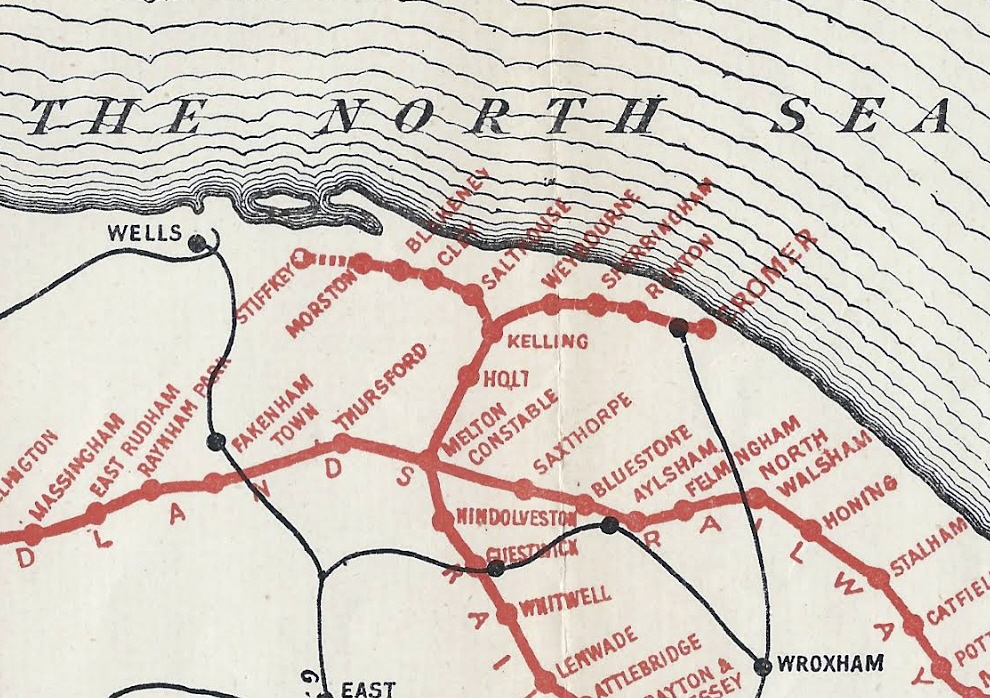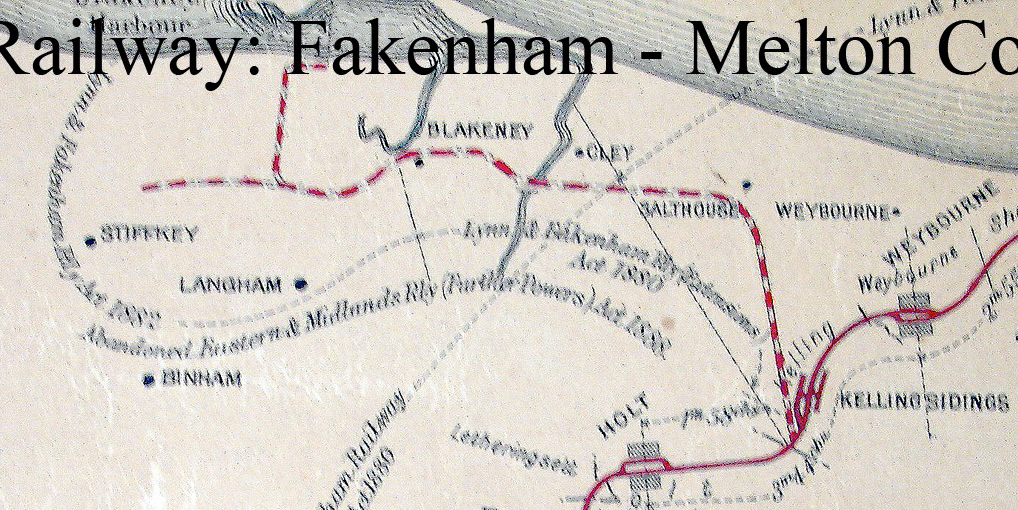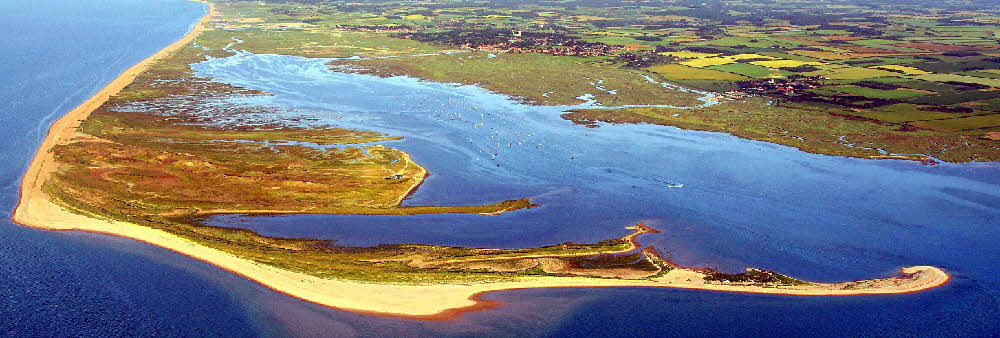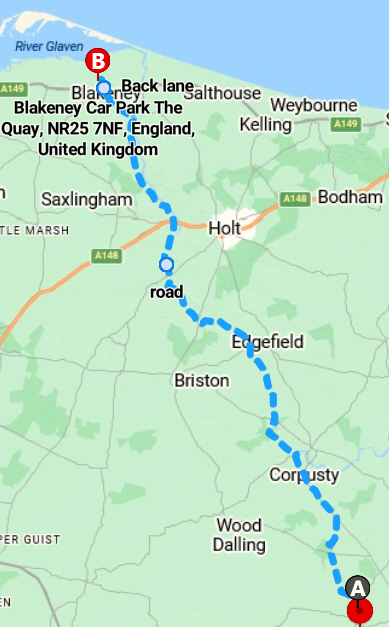
Stiffkey
MGNJR Branch

As the map (labove of the MGNJR shows the plan was more complicated than a simple branch to Blakeney. The branch was potentially to be extended to Stiffkey (some claim pronounced Stookey) or more accurately White Bridges (map below) with a spur to Morston Quay on the left-hand side of Morston Creek now shown as Landing Stages as the Quay was washed away in the 1953 floods which changed this landscape considerably.

The first station on the branch is actually at Salthouse Heath a mile from the agricultural village of Salthouse (226). (The averaged population 1881-1961). Possibly a halt or platform rather than a station.
Next is Clay (681) or Cley-Next-The-Sea on the river Glaven. An agricultural economy with a residue of shipping.
Morston, a small agricultural village (152). Possibly a halt or platform rather than a station.

The answer was Blakeney Haven (above) a deep inlet on the north coast of Norfolk into which the River Glaven flows. Sheltered behind Blakeney Point, the Haven with ports at Wiveton, Cley, Blakeney, Morston, and Stiffkey was a major shipping area in the Middle Ages. Cley & Wiveton silted up in the 17th century and Morston & Stiffkey in the 18th century. Blakeney prospered, especially after the channel to the Haven was deepened in 1817. Packet ships ran to Hull and London from 1840. In 1872 60 vessels in total approximately 4,000 tons belong to the port. The chief export was corn; the chief imports were coal, timber, iron, hemp, tar, and tallow; and a considerable fishery was carried on despite a dangerous shifting bar. Trade declined as ships became too large for the harbour and the harbour closed for trade in 1940.

The ENR was an impecunious rural railway with a mainline
Norwich - Cromer and a branch Wroxham - County School via Cawston. It rapidly
passed into the hands of the Great Eastern Railway {GER}. The branch closed to
passengers in 1952 & goods in 1981 and the Bure Valley Railway uses its track
bed Wroxham- Aylsham.
A triangular junction to the east of
Cawston
station would be the start of the branch to Blakeney.
The first station would be for the
agricultural villages of
Corpusty (406)
and Saxthorpe (266). The villages had a
station on the MGNJR.
The penultimate station is in Wiveton
but serves the agricultural village of
Wiveton (173) and
Cley (681)
(details above).
The final station is Blakeney (details above). Unlike the L&FR the station would be a terminus next to the quay possibly on land that is currently a car park.
In summery the branch (5,288) mostly in small agricultural villages with Holt and a lesser extent Blakeney being exceptions. Goods traffic would be agricultural peaking during the harvest. The only hope of profits would be the development of and Blakeney Harbour and tourism.
Modelling the ECR branch
There have been
several models of the branches. Dave Tailby's EM layout
Saxlingham is goods
only, set 1964-68, with first generation diesels. It assumes the East Norfolk
Railway's {ENR} branch had its passenger services withdrawn in 1964 and the
branch cut back to a local railhead at Saxlingham until total closure in 1968.
Traffic was mainly coal, fertiliser, seed potatoes, and sugar beet with the odd
wagonload of recovered gubbins from the Blakeney section.
Another layout is the Blakeney Point Railway set in late steam days. It's
inspired by the Lynn and Fakenham Railway's branch to Blakeney. Unfortunately
the photos stop before the layout was completed.
Given that the ENR branch was going to be unprofitable costs would have been
minimised with single track, few staff, timber buildings, ground frames rather
than signal boxes, etc.
Three stations on the line are likely to be very similar;
·
Saxthorpe & Corpusty, I've
reversed the village's names to avoid confusion with the Midland & Great
Northern Joint Railway station,
·
Edgefield for Hunworth & Stody, and
·
Wiveton & Cley.
They are based on the MGNJR's Corpusty & Saxthorpe and would comprise a loop,
siding, and to let passenger trains pass an island or two platforms.
Chelwood
gives an idea of the island platform station though longer platforms would be
better. Two points are the stone station building and platform are too good a
timber is more plausible and in model terms a ground frame hut (right) is
cheaper than a ground frame. Staff would be just as basic a junior grade station
master and two porter-signalmen, one on each shift. In the 1930s the station
master might have been withdrawn with all three stations coming under the
station master at the nearest larger station. The 1930s or 1950s might see the
loop lifted.
Letheringsett
for Holt and Glandford is based on Holt MGNJR is too wide to easily model in 00
or larger scale. The options are to have an unmodelled goods station reached by
a spur into the fiddle yard or a separate passenger station preferably on two
four foot boards then a goods station again preferably on two boards. The
station would be a loop with two platforms and a bay possibly with goods shed
and cattle pens. The goods yard would comprise two sidings with hard standing in
between and a siding against the back scene with low relief industries - co-ops
and granaries were popular in Norfolk. Some granaries were modernised post war
by the addition of large diameter piping on the outside of the building to
handle grain by suction an example is the Black Granary at Framlington.
Blakeney
would be in the same league as the smaller stations so a single platform with
loop and three sidings, carriage for the express coaches, general goods, and
quay. The siding to the quay could be an extension of the loop. An engine shed
is an option possibly out of use by the World War Two.
Train Service
The local passenger service on the Wroxham - County School line in 1908 was 5 trains a day Monday to Saturday and no Sunday service. By 1938 it had increased to 7 trains a day and a summer only round trip from Great Yarmouth. Weekday trains ran to/from Norwich (Thorpe) station. It's unlikely the local services to Blakeney would have been better. The railways tried to popularise the north eastern Norfolk coast with express suburban and tourist trains. By the 1950s the suburban train was Broadsman. The Blakeney section of a composite coach and break third would have left Blakeney shortly after 6.00 and arrive in London at 10.00 departed London 15.30 and arrived back at Blakeney about 19.00. The tourist train was by the 1950s the Norfolkman. The Blakeney section of a composite coach and break third would have left London at 09.30 arrived at Blakeney just after 13.00 departed after 16.00 and arrived in London 19.55. The north of Wroxham expresses would only stop at Holt and Blakeney so wouldn't displaced local trains. There would have been seasonal excursion trains. Local goods would have been a daily round trip with extras during the harvest.
Stock
In steam days a J17 could handle all traffic on the branch. Local passengers trains would be four then six wheel coaches and expresses would be bogie coaches. Wagons would largely be opens and vans. First generation diesel stock is popular on layouts of East Anglian branches. The local passenger service could use a four wheel railbus or a DMU. The sections off the express trains would be mark one coaches hauled by a class 31. Goods trains could be hauled by classes 31, 15, 16, or 20. Wagons would remain largely opens, vans, and latterly grain hoppers.
Modelling the MGNJR branch
The MGNJR and its
predecessors were particularly penurious and went bankrupt on several occasions.
The MGNJR branch was likely to be built to a tighter budget than ENR branch.
Stiffkey
is a quandary. The station would be
at White Bridges Quay about 1¼ miles from the village. The first quandary is a
village of about 400 wouldn't rate a station but railways in the UK prefer
terminus stations rather than terminus platforms or halts. The difference is a
halt is unstaffed and a platform is staffed by a senior porter on each shift,
handles parcels and it might have a mileage siding were traders were responsible
for loading, unloading, sheeting, etc. Another quandary is what facilities
should be provided to handle blue cockles, Prussian blue, and phosphate, pyrite,
& lime nodules. In the end I decided to cheat. I've assumed cockles and Prussian
blue are treated as parcels traffic. If space permits a station with platform &
loop, engine shed, and four sidings, general goods, nodules, quay, and carriage.
If space is tight I'd leave the engine shed and carriage siding at Blakeney, I'd
then merge the general and nodules siding, and finally I'd reduce the station to
a platform.
Morston
with its minute population would at most rate a halt and a siding to the quay. The quay siding would also be used as a mileage siding.
Blakeney
would be a through station so would need loop and island or two platforms. Goods
facilities would be a general and quay sidings. The carriage siding, &
engine shed, if any, could be at Stiffkey or Blakeney. Blakeney would be the
only passing station on the branch.
Given the tight budget Clay
would be like West Runton) - a platform and general goods siding.
Salthouse
small population suggests a platform or halt.
Train Service
The MGNJR was very much a feast and famine railway profits in the tourist season and losses otherwise. The MGNJR rarely ran express or semi-fast trains. Monday to Saturday passenger service would have been about seven trains a day with gaps in the morning and afternoon for goods trains plus seasonal excursion trains. Local passenger trains would have been short but tourist trains would have been long making long platforms desirable. The Goods service unless the quays took off would be one a day with a second during harvest.
Stock
Until 1936 modelling the MGNJR requires scratch built stock. In 1936 the London North Easter Railway absorbed the MGNJR replacing their stock with their own some of which is available ready to run. Dieselisation is as the ENR excepting the classes 105 & 106 , available from Bachmann, were ordered for the MGNJR.